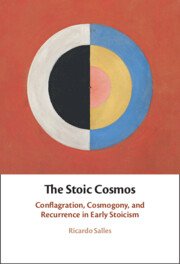Refine search
Actions for selected content:
63 results
Parapēgmata and poleis: astrometeorological calendars in the Hellenistic city
-
- Journal:
- The Journal of Hellenic Studies , First View
- Published online by Cambridge University Press:
- 26 August 2025, pp. 1-21
-
- Article
-
- You have access
- Open access
- HTML
- Export citation
Chapter 6 - The Recurring Cosmos
-
- Book:
- The Stoic Cosmos
- Published online:
- 08 July 2025
- Print publication:
- 24 July 2025, pp 174-212
-
- Chapter
- Export citation
Chapter 8 - Concluding Remarks
-
- Book:
- The Stoic Cosmos
- Published online:
- 08 July 2025
- Print publication:
- 24 July 2025, pp 247-262
-
- Chapter
- Export citation
Chapter 2 - The Conflagration
-
- Book:
- The Stoic Cosmos
- Published online:
- 08 July 2025
- Print publication:
- 24 July 2025, pp 35-63
-
- Chapter
- Export citation
Chapter 3 - Presocratic Antecedents of the Stoic Conflagration
-
- Book:
- The Stoic Cosmos
- Published online:
- 08 July 2025
- Print publication:
- 24 July 2025, pp 64-96
-
- Chapter
- Export citation
Chapter 4 - The Cosmogony
-
- Book:
- The Stoic Cosmos
- Published online:
- 08 July 2025
- Print publication:
- 24 July 2025, pp 97-124
-
- Chapter
- Export citation
Chapter 5 - The Metaphysics of Everlasting Recurrence
-
- Book:
- The Stoic Cosmos
- Published online:
- 08 July 2025
- Print publication:
- 24 July 2025, pp 125-173
-
- Chapter
- Export citation
Introduction
-
- Book:
- The Stoic Cosmos
- Published online:
- 08 July 2025
- Print publication:
- 24 July 2025, pp 1-11
-
- Chapter
- Export citation
Chapter 7 - The Paradox of Destruction and Restoration
-
- Book:
- The Stoic Cosmos
- Published online:
- 08 July 2025
- Print publication:
- 24 July 2025, pp 213-246
-
- Chapter
- Export citation
Chapter 1 - Overview of the Stoic Cosmos
-
- Book:
- The Stoic Cosmos
- Published online:
- 08 July 2025
- Print publication:
- 24 July 2025, pp 12-34
-
- Chapter
- Export citation

The Stoic Cosmos
- Conflagration, Cosmogony, and Recurrence in Early Stoicism
-
- Published online:
- 08 July 2025
- Print publication:
- 24 July 2025
Successful deployment of a large uncrewed aerial vehicle for multidisciplinary science from Rothera Research Station, Antarctica: 2024 season overview and lessons learned
-
- Journal:
- Antarctic Science / Volume 37 / Issue 4 / August 2025
- Published online by Cambridge University Press:
- 04 June 2025, pp. 291-308
-
- Article
-
- You have access
- Open access
- HTML
- Export citation
Asymptotic coefficients of the attached-eddy model derived from an adiabatic atmosphere
-
- Journal:
- Journal of Fluid Mechanics / Volume 1011 / 25 May 2025
- Published online by Cambridge University Press:
- 13 May 2025, A29
-
- Article
-
- You have access
- Open access
- HTML
- Export citation
Chapter 3 - The Architectonic ars of Architecture: Explanation and Method in Vitruvius’ De architectura
- from Part II
-
- Book:
- The <i>artes</i> and the Emergence of a Scientific Culture in the Early Roman Empire
- Published online:
- 22 March 2025
- Print publication:
- 13 February 2025, pp 81-136
-
- Chapter
- Export citation
Simulation and scaling analysis of periodic surfaces with small-scale roughness in turbulent Ekman flow
-
- Journal:
- Journal of Fluid Mechanics / Volume 992 / 10 August 2024
- Published online by Cambridge University Press:
- 30 August 2024, A8
-
- Article
-
- You have access
- Open access
- HTML
- Export citation
Chapter 6 - The Invention of Biology?
-
- Book:
- The Architecture of the Science of Living Beings
- Published online:
- 30 May 2024
- Print publication:
- 06 June 2024, pp 187-208
-
- Chapter
-
- You have access
- Open access
- HTML
- Export citation
Navigating a Hostile Medium: Observations of the Environment As an Aid to Oceanic Voyaging in the Age of Sail
-
- Journal:
- Itinerario / Volume 48 / Issue 1 / April 2024
- Published online by Cambridge University Press:
- 13 May 2024, pp. 25-41
-
- Article
-
- You have access
- Open access
- HTML
- Export citation
24 - Pseudo-Aristotle, On the Cosmos (De mundo)
- from PART IV: - Roman Period
-
- Book:
- Geographers of the Ancient Greek World
- Published online:
- 25 March 2024
- Print publication:
- 18 April 2024, pp 663-683
-
- Chapter
- Export citation
10 - Timosthenes of Rhodes
- from Part III - Hellenistic Period
-
- Book:
- Geographers of the Ancient Greek World
- Published online:
- 25 March 2024
- Print publication:
- 18 April 2024, pp 258-274
-
- Chapter
- Export citation
Extreme cold (−69.1°C) in the McMurdo Dry Valleys
-
- Journal:
- Antarctic Science / Volume 35 / Issue 2 / April 2023
- Published online by Cambridge University Press:
- 01 March 2023, pp. 120-123
-
- Article
-
- You have access
- Open access
- HTML
- Export citation


















